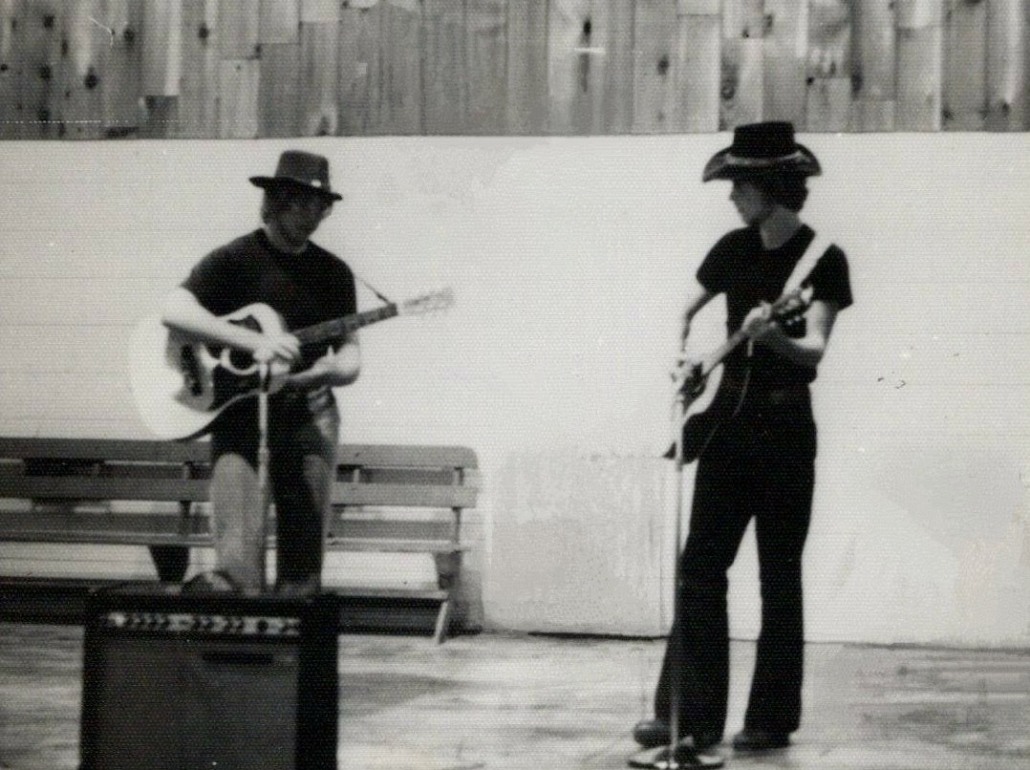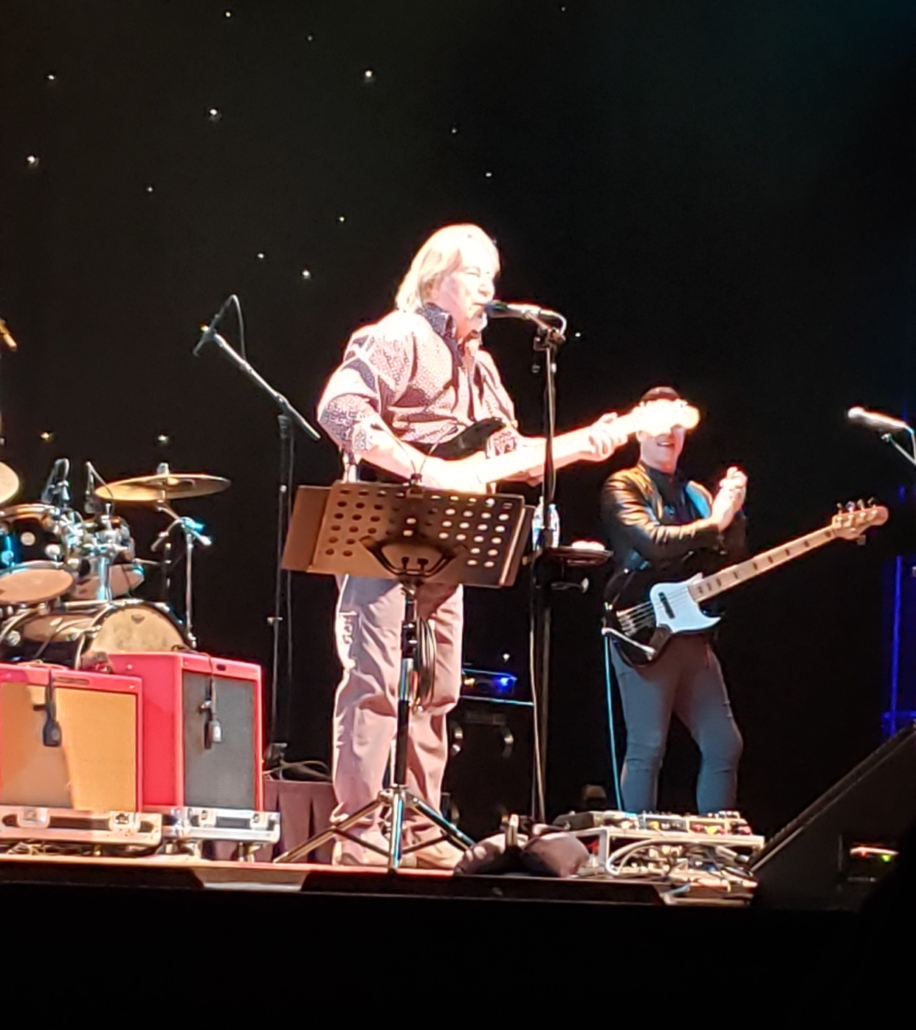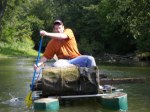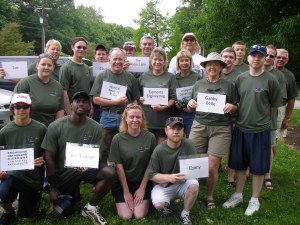
A few weeks ago, my wife Carmen and I went to see Jim Messina, you know, half of the Loggins & Messina duo from the early 70s. He and his band were playing at a small intimate theater. Our seats were in the second row. I was pumped! Messina of Poco, Buffalo Springfield, and yes, Loggins & Messina was country rock bordering on country. There was a time in my high school days when Loggins & Messina was about all I listened to. I had all their albums (that would be vinyl boys and girls). You could call this my “acoustic phase,” with Loggins & Messina, James Taylor, Bread, and more.
Jim opened with, “Thinking of You”
Something inside of me
is taking it hard each day
Something inside of me
is making me feel this way
Whenever you’re near me, you’ve got me thinking of you*
As we sang along, something started to happen. The cares of 2023 seemed to float away. With barely a pause, he flowed right into “Watching the River Run”
And it goes on and on, watching the river run
Further and further from things that we’ve done
Leaving them one by one
And we have just begun, watching the river run
Listening and learning and yearning to run, river, run**
Run, river, run…the song…1973…years before I fell in love with being on a river in a canoe…years before Carmen and I met and began to canoe together…years before my executive coach, Dan Miller, taught me the river metaphor…
The opening chords of the next song, “House at Pooh Corner,” interrupted the stunned connection I had made…rivers…rivers of life
So help me if you can, I’ve got to get
Back to the house at Pooh Corner by one
You’d be surprised, there’s so much to be done
Count all the bees in the hive
Chase all the clouds from the sky
Back to the days of Christopher Robin and Pooh***
Suddenly, I was no longer in the theater. I was in a place quite familiar yet, long forgotten. In front of me on stage were two teenagers playing guitars…acoustic guitars. The song they were playing was beautiful. The guitars weave the melody together almost as one. “Loggins & Messina Suite #9″…of course! I wrote that song, rather, Terry Webster and I wrote that song in the summer of ‘75. We were 17. We were both into Loggins & Messina, so, of course, when we wrote an instrumental using our acoustic guitars, we had to name it in there honor!
Wait! How did those two kids know that song…I looked closer…the one on the left looked a lot like Terry…maybe his kid? Who am I kidding, could be his grandson. But, the kid on the right…the kid on the right…that was ME! As the final notes faded into the air, he looked right at me. My palms began to sweat. My heart was racing. I gulped as he walked toward me. Holy shit! What would I say? What would I tell my 17-year-old self?
He put down his guitar. He put down MY guitar. He nodded, and I picked it up. Soon, I was playing the bridge to “Loggins & Messina Suite #9”. Then it came to me. This is the little tune I play for my grandson Jordan! How could I have forgotten? I turned to me…well, the 17-year-old who would be me.
“You would love Jordan. He’s such a great kid! Actually, you’d love all your grandkids!”
“Grandkids, what are you talking about out, old man, I’m 17.”
“Jeff, I’m you. We have six grandkids, with another on the way.”
“What? You can’t be me. Grandkids?!!? At least I know what happened to your hair,” he laughed.
“Man, we have a lot to talk about! Let’s go for a walk.”
Son put down that guitar
If I really had the chance to talk to my 17-year-old self, I would have a lot to say.
When I was 17, the only thing I could think about was being a rock star. It consumed almost every waking moment, it had since I was 10 or 11. There I was, a junior in high school, and I had no plan other than playing guitar and writing music. I had no idea where to go to college (not going was not a choice). I opted to go to Indiana State to major in music theory and composition because I had three other friends going there, including Terry.
What I would SCREAM at my younger version is to put down the guitar…you have no talent (I didn’t), you have no drive (I rarely did anything other than jam), and the lyrics you are writing are simplistic. I doubt I would have listened. I certainly didn’t listen to those around me at the time…but, hey, maybe I would listen to my old man-self.
I would tell him to pick up a keyboard. In 1975 computers filled rooms. We had a couple of weeks of Fortran programming in Miss Hobson’s math class. We had to write the programs out longhand, then take turns at the one keypunch machine. Our punch cards were then sent downtown, and maybe, just maybe, they would run.
Sometime during my Junior or Senior year, our school was fortunate enough to be on the rotation for a mid-range computer that was sent to various schools in the area. It was for the “computer club.” I think I got to see it one time because I was not in the club. Only nerds were in the computer club, and I. was. not. a. nerd! (Well, I was, I just didn’t know it yet.). The only thing I ever remember them doing on the computer was running horse race simulations. At any rate, I didn’t touch it.
If I had the chance, I would tell the much-younger-version of me that one day, in the not-so-distant future, he would fall hopelessly and madly in love…with writing software. He would study day and night. He would read countless textbooks. He would learn from those around him. And he would become a rock star…in software development. If only I had the chance to tell him…
Don’t be in such a hurry
At 17, I was in a hurry. In a hurry to finish high school. In a hurry to grow up. I wanted that big break that would allow me to become a star. What the 17-year-old-me could not have known was what I would miss.
I opted to take part in the work-study program during my senior year. You see, despite not really studying, I was a good student. I could have graduated early, but my parents would not allow it. What they did agree to was the work-study program. While other kids were having an incredible senior year, I got out of school at 11 o’clock and went to my job. You see, I wanted things. I wanted a car of my own. I wanted to visit my girlfriend, who lived several hours away. I wanted to impress her, she was two years older than I was and already in college.
So while others were doing all the things seniors did, I went to work. I rarely hung out with my peers. I became a bit of a loner because, well, my girlfriend didn’t live in Evansville. Today, when I look back, I only remember a handful of kids from high school. I lost touch with them in my haste to grow up.
My 17-year-old self would laugh at the thought of getting married at the end of my first semester of college, yet, that is what I did. Married, at 18. I was in love. We were going to make it work. I dropped out of school after one semester and got a job at a sporting goods store, and dreamed of opening a record store (hey, if I couldn’t make records, I would sell them). I would move my wife to Elgin, Illinois, so that I could attend a small liberal arts college and major in creative writing. I would drop out of school again, promising to return when my wife graduated.
And, in 1978, at the age of 20, we would have a son. A beautiful baby boy. A boy, with a boy.
Growing up too fast. I got a full-time job at a bank, working collections on bad credit card debt. I still wrote music, but the life of a rock star seemed so very far away. The marriage would last twenty-three years and give me two incredible sons before it ended in a very painful divorce.
I would tell that version of me to slow down. To enjoy being 17, 18, 19. To stay in school. To study computer science. If it were right, she would still be there. I probably wouldn’t have listened, lord knows my parents had tried to tell me.
Stop following and start to lead
Following was easy. Heck, I chose what college to attend because three kids next to me in the circle, when asked where they were going to college and what their major would be, answered Indiana State and music. It was the first time I ever declared it. I answered because it was the easy choice…to follow.
Growing up, my mom used to joke that, unlike the old cigarette ad, I would rather switch than fight. What she saw as a peacemaker, I saw as following. It was easier.
Even after growing up and becoming a computer programmer (a “dev” as we call them today), I would rather code. I was gifted. I could listen to someone describe a problem they were having, and I could solve the problem with code. The computer keyboard became my instrument, and I could make it ROCK! Be a manager, no! Be a leader, hell NO!
There is a debate about leaders…are they born or made. As I look back, I was always a leader. The other kids always followed me (good or bad). When I was 10 or 11, a minister asked a group of kids to name a great leader; one of the younger kids piped up and said, “Jeff Ton,” much to the laughter of the congregation. In high school, despite becoming a loner in my Junior and Senior years, prior to that, I led at church, in my neighborhood, in Scouts, and at school. Rarely in a position of leadership but naturally leading those around me.
Still, it was easy to follow. Leading was hard. Following meant I could blame the leader. Leading meant “playing politics.” 17-year-old Jeff would be stunned to see 65-year-old Jeff. After getting dragged, kicking, and screaming into leadership, I became quite good at it. I led teams across the globe. I led departments. I led companies. I have led a community of my peers for over a decade. I now teach leadership to executives and emerging leaders alike.
Step up! Find your voice! For god’s sake, lead!
The River
The river runs. Always changing.
If I had the chance, I would say all these things and more to the younger me.
“Talk to your parents and grandparents. You will have questions for them when they are gone.”
“Don’t do it!” (boy, THAT covers a LOT of ground)
“Oh, and go back to history class and study Lewis & Clark. You won’t believe how THAT turns out!”
But, honestly, I hope me wouldn’t listen. I hope me would travel the river exactly the way we traveled it. I would not want to miss all the joy and laughter. I would not want to miss all the pain and tears. I would not want to change anything because, looking back on 65 years, that river made me who I am today. It gave me a wonderful wife and partner, two incredible sons, six (soon to be seven) grandkids, several dear, dear friends, and a community of hundreds of peers.
And it goes on and on, watching the river run
Further and further from things that we’ve done
Leaving them one by one
And we have just begun, watching the river run
Listening and learning and yearning to run, river, run**
*Songwriters: Jim Messina - Thinking of You lyrics © Concord Music Publishing LLC ** Songwriters: Jim Messina / Kenny Loggins - Watching the River Run lyrics © Concord Music Publishing LLC, Gnossos Music / Milk Money Music, Universal Music Publishing Group *** Songwriters: Kenneth Clark Loggins - House at Pooh Corner lyrics © American Broadcasting Music, Inc.


 I could go on and on…but what I really wanted to do was to thank the 14 people that gave up 5 or 6 hours of a gorgeous September Saturday morning to provide the muscle needed to accomplish this daunting task! Our 11 canoeists were ably supported by a land crew of three that helped shuttle us along the route and made sure lunch was ready when we were finished. The 11 members of the water crew weere in six canoes (thanks Alan for volunteering to go solo!) and had a fantastic barge provided by the City of Noblesville. Within the first quarter mile we had amassed so much stuff, we had to offload the barge and a couple of canoes at the 206th bridge, where a group of boy scouts helped to move it to the dumpsters.
I could go on and on…but what I really wanted to do was to thank the 14 people that gave up 5 or 6 hours of a gorgeous September Saturday morning to provide the muscle needed to accomplish this daunting task! Our 11 canoeists were ably supported by a land crew of three that helped shuttle us along the route and made sure lunch was ready when we were finished. The 11 members of the water crew weere in six canoes (thanks Alan for volunteering to go solo!) and had a fantastic barge provided by the City of Noblesville. Within the first quarter mile we had amassed so much stuff, we had to offload the barge and a couple of canoes at the 206th bridge, where a group of boy scouts helped to move it to the dumpsters.




